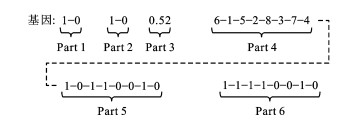Optimization model of short-distance liner ship route based on tripartite game
-
摘要: 考虑政府补贴、碳排放控制以及货主运输方式选择, 提出基于航线运营者、货主和政府三方博弈关系的短途班轮航线优化模型。应用用户平衡原理, 模型可优化航线配船与航线结构设计, 计算恰当的政府补贴额。开发了基于时空网络拓展和Frank-Wolf算法的遗传算法求解模型, 并对渤海西部短途航线进行了优化。研究结果表明: 在政府补贴为1 121.28元.d-1时, 运营者若采用9艘40 000t级滚装船在渤海西部区域各主要港口间布设单摆式航线, 每船可获得704 567.12元.d-1的收益, 碳排放强度下降约17.78%;若期望碳排放强度下降20%以上, 运营者应采用8艘40 000t级滚装船做环绕航行, 可为运营者带来956 264.83元.d-1的收益, 使碳排放强度下降约27.23%, 但需要政府提供56 075.26元.d-1的高额补助。计算结果符合预期, 优化模型有效。Abstract: Government subsidy, carbon emission control, shippers' choices of transport modes were considered, the optimization model of short-distance liner ship route was developed based on tripartite game relations among carriers, shippers and government. The model could not only optimize the fleet deployment and structure design of ship route simultaneously, but also work out the reasonable amount of government subsidy by using user equilibrium principle. A genetic algorithm based on time-space network expansion and Frank-Wolf algorithm was developed to solve the model, and short-distance liner ship routes in the western area of Bohai Bay were optimized. Analysis result shows that when pendulum-pattern route among major ports in the western area of Bohai Bay is deployed with 9 ro-ro ships of 40 000 t, and government subsidy is 1 121.28 yuan · d-1, the total benefit of per ship is 704 567.12 yuan· d-1, carbon emission reduces by about 17.78%. When carbon emission is expected to decrease by more than 20%, circle-pattern route is deployed with 8 ro-ro ships of 40 000 t, the route can bring total benefit of 956 264.83 yuan · d-1 for carriers, reduce carbon emission by about 27.23%, but government subsidy reaches up to 56 075.26 yuan· d-1. The calculating result accords with the expectation result, so the optimization model is effective.
-
表 1 OD矩阵
Table 1. OD matrix
t·d-1 
表 2 计算结果
Table 2. Calculation results

-
[1] RONEN D. Cargo ships routing and scheduling: survey of models and problems[J]. European Journal of Operational Research, 1983, 12(2): 119-126. doi: 10.1016/0377-2217(83)90215-1 [2] RONEN D. Ship scheduling: the last decade[J]. European Journal of Operational Research, 1993, 71(3): 325-333. doi: 10.1016/0377-2217(93)90343-L [3] CHRISTIANSEN M, FAGERHOLT K, RONEN D. Ship routing and scheduling: status and perspectives[J]. Transportation Science, 2004, 38(1): 1-18. doi: 10.1287/trsc.1030.0036 [4] SHINTANI K, IMAI A, NISHIMURA E, et al. The container shipping network design problem with empty container repositioning[J]. Transportation Research Part E: Logistics and Transportation Review, 2007, 43(1): 39-59. doi: 10.1016/j.tre.2005.05.003 [5] RICHA A, ÖZLEM E. Ship scheduling and network design for cargo routing in liner shipping[J]. Transportation Science, 2008, 42(2): 175-196. doi: 10.1287/trsc.1070.0205 [6] HANE C A, BARNHART C, JOHNSON E L, et al. The fleet assignment problem: solving a large-scale integer program[J]. Mathematical Programming, 1995, 70(1/ 2/ 3): 211-232. [7] HSU C I, H SIEH Y P. Routing, ship size, and sailing frequency decision-making for a maritime hub-and-spoke container network[J]. Mathematical and Computer Modelling, 2007, 45(7/ 8): 899-916. [8] CHEN Chao, ZENG Qing-cheng. Design container shipping network under changing demand and freight rates[J]. Transport, 2010, 25(1): 46-57. [9] RANA K, VICKSON R G. A model and solution algorithm for optimal routing of a time-chartered containership[J]. Transportation Science, 1989, 22(2): 83-95. [10] 寿涌毅, 赖昌涛, 吕如福. 班轮船舶调度多目标优化模型与蚁群算法[J]. 交通运输工程学报, 2011, 11(4): 84-88. http://transport.chd.edu.cn/article/id/201104013SHOU Yong-yi, LAI Chang-tao, LU Ru-fu. Multi-objective optimization model and ant colony optimization of liner ship scheduling[J]. Journal of Traffic and Transportation Engineering, 2011, 11(4): 84-88. (in Chinese) http://transport.chd.edu.cn/article/id/201104013 [11] 谢新连, 李树范, 纪卓尚, 等. 船队规划的线性模型研究与应用[J]. 中国造船, 1989(3): 59-66. https://www.cnki.com.cn/Article/CJFDTOTAL-ZGZC198903005.htmXIE Xin-lian, LI Shu-fan, JI Zhuo-shang, et al. Study and application on the linear model of fleet planning[J]. Shipbuilding of China, 1989(3): 59-66. (in Chinese) https://www.cnki.com.cn/Article/CJFDTOTAL-ZGZC198903005.htm [12] HERSH M, LADANY S P. Optimal scheduling of ocean cruises[J]. INFOR, 1989, 27(1): 48-57. [13] GELAREH S, NICKEL S, PISINGER D. Liner shipping hub network design in a competitive environment[J]. Transportation Research Part E: Logistics and Transportation Review, 2010, 46(6): 991-1004. doi: 10.1016/j.tre.2010.05.005 [14] YAMADA T, RUSS B F, CASTRO J, et al. Designing multimodal freight transport networks: a heuristic approach and applications[J]. Transportation Science, 2009, 43(2): 129-143. doi: 10.1287/trsc.1080.0250 [15] MENG Qiang, WANG Xin-chang. Intermodal hub-and-spoke network design: incorporating multiple stakeholders and multi-type containers[J]. Transportation Research Part B: Methodological, 2011, 45(4): 724-742. doi: 10.1016/j.trb.2010.11.002 [16] 孙海雷, 刘琼荪, 胡上尉. TSP问题的顺序插入交叉算子[J]. 计算机工程与应用, 2007, 43(8): 65-66, 98. doi: 10.3321/j.issn:1002-8331.2007.08.022SUN Hai-lei, LIU Qiong-sun, HU Shang-wei. Order insert crossover operator for TSP[J]. Computer Engineering and Applications, 2007, 43(8): 65-66, 98. (in Chinese) doi: 10.3321/j.issn:1002-8331.2007.08.022 -





 下载:
下载:















